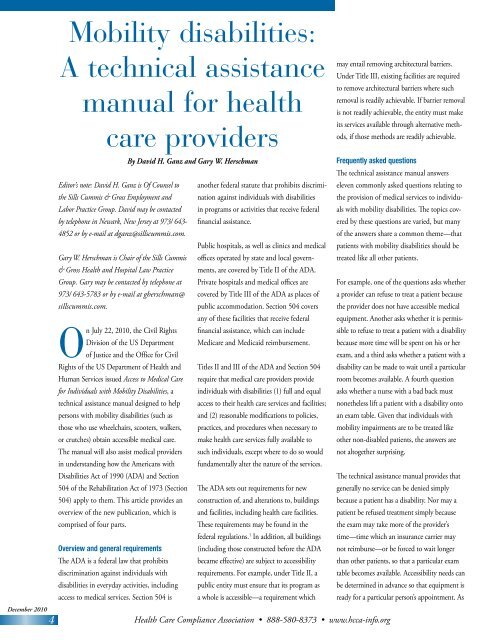Steven Baruch - Health Care Compliance Association
Steven Baruch - Health Care Compliance Association
Steven Baruch - Health Care Compliance Association
You also want an ePaper? Increase the reach of your titles
YUMPU automatically turns print PDFs into web optimized ePapers that Google loves.
December 2010<br />
4<br />
Mobility disabilities:<br />
A technical assistance<br />
manual for health<br />
care providers<br />
Editor’s note: David H. Ganz is Of Counsel to<br />
the Sills Cummis & Gross Employment and<br />
Labor Practice Group. David may be contacted<br />
by telephone in Newark, New Jersey at 973/ 643-<br />
4852 or by e-mail at dganz@sillscummis.com.<br />
Gary W. Herschman is Chair of the Sills Cummis<br />
& Gross <strong>Health</strong> and Hospital Law Practice<br />
Group. Gary may be contacted by telephone at<br />
973/ 643-5783 or by e-mail at gherschman@<br />
sillscummis.com.<br />
On July 22, 2010, the Civil Rights<br />
Division of the US Department<br />
of Justice and the Office for Civil<br />
Rights of the US Department of <strong>Health</strong> and<br />
Human Services issued Access to Medical <strong>Care</strong><br />
for Individuals with Mobility Disabilities, a<br />
technical assistance manual designed to help<br />
persons with mobility disabilities (such as<br />
those who use wheelchairs, scooters, walkers,<br />
or crutches) obtain accessible medical care.<br />
The manual will also assist medical providers<br />
in understanding how the Americans with<br />
Disabilities Act of 1990 (ADA) and Section<br />
504 of the Rehabilitation Act of 1973 (Section<br />
504) apply to them. This article provides an<br />
overview of the new publication, which is<br />
comprised of four parts.<br />
Overview and general requirements<br />
The ADA is a federal law that prohibits<br />
discrimination against individuals with<br />
disabilities in everyday activities, including<br />
access to medical services. Section 504 is<br />
By David H. Ganz and Gary W. Herschman<br />
another federal statute that prohibits discrimination<br />
against individuals with disabilities<br />
in programs or activities that receive federal<br />
financial assistance.<br />
Public hospitals, as well as clinics and medical<br />
offices operated by state and local governments,<br />
are covered by Title II of the ADA.<br />
Private hospitals and medical offices are<br />
covered by Title III of the ADA as places of<br />
public accommodation. Section 504 covers<br />
any of these facilities that receive federal<br />
financial assistance, which can include<br />
Medicare and Medicaid reimbursement.<br />
Titles II and III of the ADA and Section 504<br />
require that medical care providers provide<br />
individuals with disabilities (1) full and equal<br />
access to their health care services and facilities;<br />
and (2) reasonable modifications to policies,<br />
practices, and procedures when necessary to<br />
make health care services fully available to<br />
such individuals, except where to do so would<br />
fundamentally alter the nature of the services.<br />
The ADA sets out requirements for new<br />
construction of, and alterations to, buildings<br />
and facilities, including health care facilities.<br />
These requirements may be found in the<br />
federal regulations. 1 In addition, all buildings<br />
(including those constructed before the ADA<br />
became effective) are subject to accessibility<br />
requirements. For example, under Title II, a<br />
public entity must ensure that its program as<br />
a whole is accessible—a requirement which<br />
<strong>Health</strong> <strong>Care</strong> <strong>Compliance</strong> <strong>Association</strong> • 888-580-8373 • www.hcca-info.org<br />
may entail removing architectural barriers.<br />
Under Title III, existing facilities are required<br />
to remove architectural barriers where such<br />
removal is readily achievable. If barrier removal<br />
is not readily achievable, the entity must make<br />
its services available through alternative methods,<br />
if those methods are readily achievable.<br />
Frequently asked questions<br />
The technical assistance manual answers<br />
eleven commonly asked questions relating to<br />
the provision of medical services to individuals<br />
with mobility disabilities. The topics covered<br />
by these questions are varied, but many<br />
of the answers share a common theme—that<br />
patients with mobility disabilities should be<br />
treated like all other patients.<br />
For example, one of the questions asks whether<br />
a provider can refuse to treat a patient because<br />
the provider does not have accessible medical<br />
equipment. Another asks whether it is permissible<br />
to refuse to treat a patient with a disability<br />
because more time will be spent on his or her<br />
exam, and a third asks whether a patient with a<br />
disability can be made to wait until a particular<br />
room becomes available. A fourth question<br />
asks whether a nurse with a bad back must<br />
nonetheless lift a patient with a disability onto<br />
an exam table. Given that individuals with<br />
mobility impairments are to be treated like<br />
other non-disabled patients, the answers are<br />
not altogether surprising.<br />
The technical assistance manual provides that<br />
generally no service can be denied simply<br />
because a patient has a disability. Nor may a<br />
patient be refused treatment simply because<br />
the exam may take more of the provider’s<br />
time—time which an insurance carrier may<br />
not reimburse—or be forced to wait longer<br />
than other patients, so that a particular exam<br />
table becomes available. Accessibility needs can<br />
be determined in advance so that equipment is<br />
ready for a particular person’s appointment. As

















